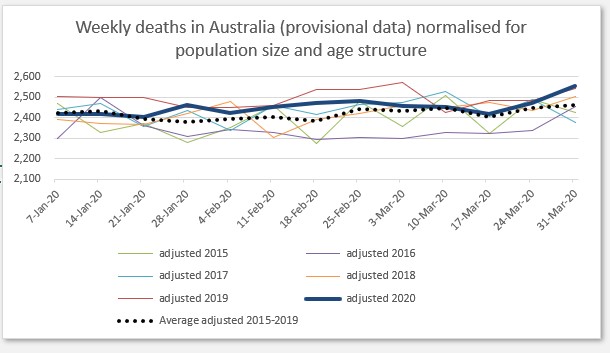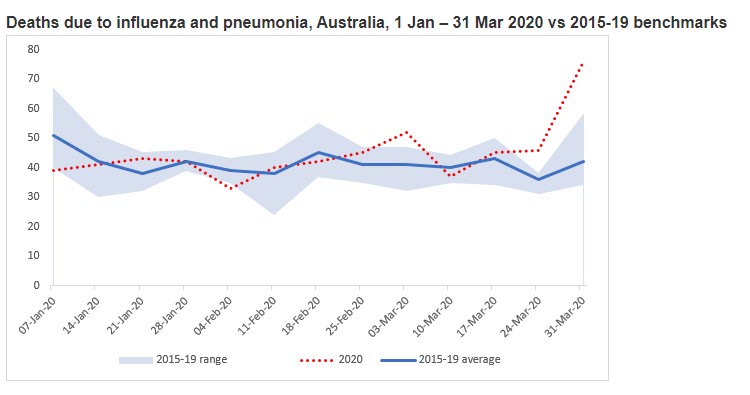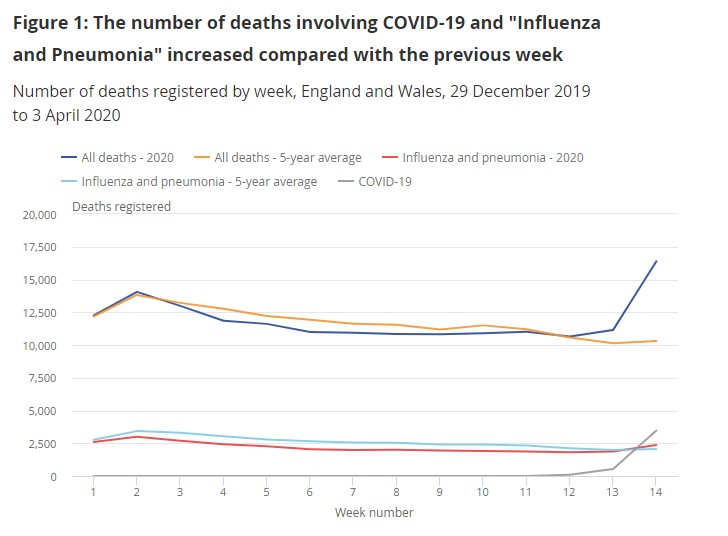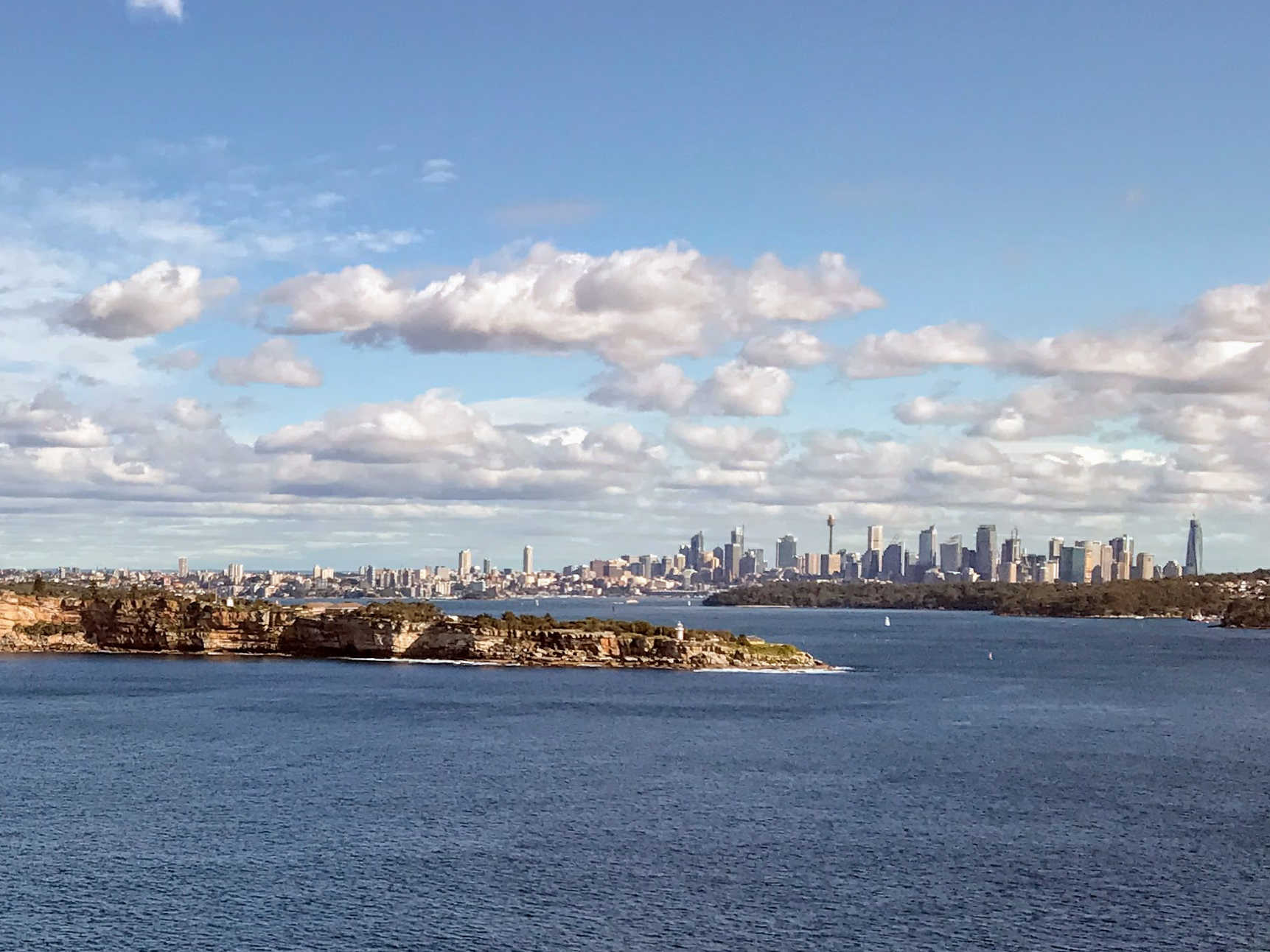In many countries, population mortality statistics have revealed a much worse Covid 19 epidemic than is being shown by the case and official death statistics. Australian statistics have not been released for 2020 until this week (with data up to the end of March). They suggest that it is possible that some Covid19 deaths have been missed from the statistics, in the last week or two in March, but the increase is still plausibly random fluctuation.

This week the ABS released provisional weekly mortality statistics for Australia for the three months to March. They are planning to update the statistics every month from now on. This is a massive step forward for the ABS, which has previously released annual statistics in around November (I often blog about them).
However, it is still nearly three months ago. According to one of my Australian favourite tracking sites, officially there had been 19 deaths from Covid19 in Australia by 31 March (all in March), so with an average of around 2,500 deaths a week in Australia, Covid19 should not be changing the statistics.
You can see from the graph that there is a little spike in the last week in March, and the second last week is also a bit higher than the long term average. However there given how close the numbers still are to a long term average, I thought it was worth making sure we were comparing like with like. Two things happen every year in Australia that will affect the number of deaths without any novel diseases. First, every year there are more people – the population grows by about 1.5%. And second, which matters quite a lot for death statistics, the population, on average, gets older. This matters because after age 10, mortality rates go up every year. After your 40s, an extra year of age increases the chances of you dying that year by around 10% – so a 40 year old has a 0.1% chance of dying next year, while a 50 year old has a 0.2% chance of dying next year.
The combination of these two effects means that each year we would expect about 3% more deaths every week than the previous year in Australia. The ABS graph I’ve shown above doesn’t correct for that. I’ve recast it below, and the spike in the last week of March doesn’t look quite as dramatic.

The last week in March has higher deaths (even when normalised) than the previous five years, but only slightly. There is some extra information provided by the ABS that is somewhat suggestive that there were extra deaths from Covid19 than officially recorded, though. This graph below shows the influenza and pneumonia deaths compared with the previous five years. Deaths that were recognised as Covid19 should not be included in these statistics, as they have a different code. Given the timing, a spike in these statistics (with the total in the last week in March around 30 more deaths that week than the recent averages) raises the possibility of more Covid19 deaths in Australia than officially recognised.

And for completeness, and a reminder of how lucky we are in Australia, here is the equivalent period for England and Wales (published on 14 April). There is no question that Covid 19 is causing excess deaths in the last two weeks of March, with nearly 4,500 Covid 19 deaths shown in the last two weeks of this graph.

Link
As I’m starting to see a few people back in the office on my zoom calls this link looking at whether the open plan office has a future is interesting.
There’s a deeper question that needs to be solved at the heart of this effort to virus-proof the open office. What, exactly, is so valuable about working together in the same physical space? If the goal is to again nurture in-person collaboration, office design will have to find ways of making such face-to-face interactions feel safe and comfortable again.
There is something about the accidental interactions of the office that is valuable, and harder to achieve remotely. But designing it for the next few years is going to be challenging. Another view of this comes from 1843 (the lifestyle magazine of The Economist):
Humans need offices. Online encounters may be keeping us alive as social beings right now, but work-related video meetings are too often transactional, awkward and unappealing. After the initial joy of peering into each other’s houses on Zoom, we are confronted with people’s heads looming even closer than we see them across the desk at work, and we gaze in horror – half of it self-awareness that we, too, must look awful – at thinning hair and double chins. We become freakish specimens rather than people. No Skype chat can replicate what Heatherwick calls the “chemistry of the unexpected” that you get in person. Offices may not fill the pages of poetry anthologies but, says Kellaway, they “can be as moving as anywhere on Earth. Because what moves us is not sitting at our computer, it’s the relationship that we have with people.”
Life Glimpses
As we’ve started to get used to this life of isolation, we’ve started treating it as a bit more long term in our house. And that’s extending to what we’re buying. Today we bought a slow cooker, to make it possible to have a classic winter stew with the bread I’ve been perfecting (the only downside of this NY Times recipe is that it uses the same cast iron casserole oven we use for stew). We’ve gradually been getting better electronics for our zoom setup (webcam, microphone, screen). And I’m researching running gear with pockets, now that I’ve resigned myself to carrying hand sanitiser and water as well as my phone on all my runs for the foreseeable future.
Bit of Beauty
Today’s Bit of Beauty comes from North Head, the mouth of Sydney harbour, where we went this week to see if we could see some whales migrating. And we did! (too far away to take a picture though). It was a glorious winter Sydney day, and well worth the effort of getting there. That’s South Head in the foreground of the picture.


Thank you for going to North Head, thank you for taking such a photo, magic. Did you see any whales.
As regarding running gear with pockets, is it a problem to find ?
Congratulations on your new slow cooker. Did you know that in Italy they have an association called
Slow Food.
Love
Marta
Hi Jennifer – Reading this in Ireland where today they announced that they believe they have over-stated the COVID-19 deaths (the increase in mortality is lower than the reported COVID-19 deaths). We’re talking c600 of 1.7K. While personal experiences are always a dangerous mix with statistics, one of my Mum’s friends died of a brain aneurysm after a lengthy time in hospital, her corpse was positive for COVID-19 and she was recorded as a COVID death even though she had been discharged less than a week earlier with no symptoms. It can get confusing,
By the way, thinking of how disappointed you and your mother must be not to be heading to the 2020 Olympics in Tokyo – hopefully you can both get to go in 2021.
Thanks for pointing me to that research Anne, it is really interesting. I did see South Africa actually had lower deaths than normal early on but they think that was reduced traffic accidents, unlikely to be the same reason in Ireland, particularly for such a large number.
We are still hoping we will get to go to the Olympics, but for now, I’m thinking quite a lot will have to happen in the next 12 months for the borders to be open enough. Let’s hope it happens